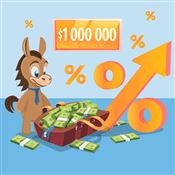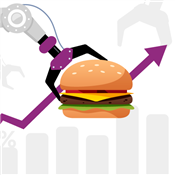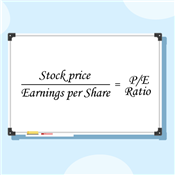How Much Money to Live off Dividends
Interested in earning passive income with dividend-paying stocks? Find out how much money you need to invest in order to live off your dividends.
 |
When you own a stock that pays dividends, you're essentially earning passive income.
But can you actually live off of it?
After all, that's the goal.
In this guide, find out how much money it would take to live off dividends. Plus, learn how dividends impact your taxes and whether dividend stocks are high-risk.
How Can I Live off Dividends?
You can live off of dividends by investing enough so that the amount you receive each year covers your annual expenses.
It all comes down to two factors you'll want to keep in mind:
- How much money you're earning in dividends
- How much you're spending each year
Living off of dividends usually requires you to live frugally. In fact, much of your journey towards financial independence will involve finding ways to cut your spending.
To figure out your budget and spending needs, consider the following factors:
- Do you have any dependents? More people means more money needed for food, housing, and other necessities. The same goes if you're supporting a spouse.
- How do you get around? Some places have convenient public transit, or offer the ability to get around by bicycle, but in others, a car is a necessity. An expensive one.
- What's the cost of living in your area? The cost of rent, food, and other necessities varies from place to place. The place you can afford to live may not be the place you want to live.
- Do you have any medical conditions that require treatment? In the U.S. especially, the cost of health care can heavily affect a family's financial planning.
- How much do you need for discretionary spending? Living off of passive income until you can't afford to spend it doing the things you enjoy.
How Much Money Is Needed to Live off Dividends?
How much money you need to live off dividends depends on the dividend yield. This number varies from one investor to another, but a realistic dividend yield generally lies somewhere between 1% and 6%.
To provide you some examples, The Motley Fool put together of some of the top dividend-earning index funds with low expense ratios and varying degrees of risk. Here are a few of them.
| Index Fund | Dividend Yield | Expense Ratio | Risk Level |
|---|---|---|---|
| Invesco S&P 500 High Dividend Low Volatility ETF (NYSEMKT:SPHD) | 4.89% | 0.30% | Average |
| Schwab U.S. Dividend Equity ETF (NYSEMKT:SCHD) | 3.16% | 0.06% | Below Average |
| Vanguard Dividend Appreciation Index ETF (NYSEMKT:VIG) | 1.67% | 0.06% | Below Average |
To find the dividend yield, look at the historical dividend yields for any given asset. This isn't a guarantee of what you'll earn, but it will give you an idea of what it might pay out in the future.
Then, try running some scenarios to figure out how much to invest.
For example, if you invest $1 million in a dividend-earning portfolio that has a dividend yield of 6%, your math would look like this:
$1,000,000 x 0.06 = $60,000
In this situation, you would be able to live off of your dividends if your living expenses are less than $60,000 per year.
You can also start with your cost of living and do the math in reverse to figure out how much you'd need to invest to support yourself. Say your cost of living is only $50,000 a year:
$50,000 / 0.06 = $833,333.33
Divide your annual needs by the dividend yield as a percentage to get the necessary investment.
That said, not everyone will be able to get a 6% dividend yield. For the same lifestyle, as the yield drops, the size of the initial investment dramatically increases. Here's what it looks like at a 2% yield:
$50,000 / 0.02 = $2,500,000
As you can see, the yield is a big factor. Even a small decrease in the dividend yield more than doubled the necessary investment.
Are Dividend Stocks High Risk?
 |
Stocks that pay high dividends often carry high amounts of risk.
This is because dividends are often used by the company as an incentive to get investors to buy them. So a generous incentive might indicate that the company itself isn't as stable as you'd like.
In many cases, the dividend yield goes up when the value of a stock goes down. So while you're optimizing your portfolio for the highest-paying dividends, you may also be selecting stocks that will drop in value, which means losses for you in the end.
That's why it's important to consider the sustainability of a dividend stock before buying it. When you're researching stocks, consider the difference between their dividend payouts and their net income.
If too much of their net income is going to investors, their business model may be unsustainable in the long term.
How Do Dividends Affect Taxes?
You'll need to take taxes into account as part of your cost of living when planning to live off your dividends.
It is possible to take earnings tax-free from dividends if your investments are in an after-tax account, such as a Roth IRA or 401(k). However, other brokerage accounts will incur taxes at different rates.
You'll need to know whether your dividends are qualified or ordinary. Qualified dividends are usually taxed at the same tax rate that applies to capital gains, while ordinary (non-qualified) dividends are generally taxed as ordinary income.
Qualified dividends may be taxed at rates of 0%, 15%, or 20%, while ordinary dividends are taxed between 10% and 37%.[1][2]
You won't pay taxes on your dividends as long as you reinvest them in typical retirement accounts.[3]
If you are paying taxes on your dividends, that's a fair chunk of your income, so be sure to plan carefully to deal with the expense.
Bottom Line
The cost of living varies widely from place to place and person to person. In Mississippi, the state with the lowest cost of living in the U.S., the median household income was $46,511 per year, while in California, it is just $78,672.[4]
Depending on the lifestyle you expect and where you live, as well as how many people you need to support, living off of dividends may or not be possible.
Remember to plan carefully and to take all of your expenses into account before investing all of your savings in dividend stocks. And always remember that every investment carries some degree of risk.
References
- ^ Internal Revenue Service. Investment Income and Expenses, Retrieved 5/5/2022
- ^ Internal Revenue Service. IRS provides tax inflation adjustments for tax year 2022, Retrieved 5/5/2022
- ^ Internal Revenue Service. Traditional and Roth IRAs, Retrieved 5/5/2022
- ^ US Census Bureau. QuickFacts: Mississippi; California Median Household Income 2020, Retrieved 5/5/2022
Jeremy Harshman is a creative assistant at CreditDonkey, a personal finance comparison and reviews website. Write to Jeremy Harshman at jeremy.harshman@creditdonkey.com. Follow us on Twitter and Facebook for our latest posts.
|
|
| ||||||
|
|
|











